We have tested so many cordless drills that we’ve literally lost count. From filling our shop with 50 drills at one time to testing new models as they come out, we constantly have our hands on the latest models. Choosing the best cordless drill for you depends on your highest priorities: performance, durability, price, value, weight, size, and the list goes on!
Even though we’ve tested a TON of drills (I wonder that the actual weight of all of them adds up to…), not everyone gets a trophy. To make our final list, the drill has to stand out from its competition. There are other models we still recommend, they’re just not in this group that we call the best.
Best Cordless Drill
Flex 24V Max Hammer Drill with Turbo

The Flex 24V Max Hammer Drill with Turbo Mode earned a final rating of 9.8 to stand at the top of the charts. It finished in the top 3 of every test we ran, but it’s still compact at just 7.1 inches long. At $249 for the kit including two batteries and backed by a 5-year warranty, its value proposition is also very attractive value.
While it is on the heavier side and its list of compatible tools isn’t as broad as DeWalt, Makita, and Milwaukee just yet, its performance and design set it apart in a tough competition among cordless drills.
Price: $249 kit with 5.0Ah and 2.5Ah batteries
The Best 18V Cordless Drill is the Best 20V Cordless Drill
When it comes to the creme de la creme, are you looking for the best 18V cordless drill or the best 20V cordless drill? Yes!
18V tool and 20V tools have the same voltage. They both operate on 5-cell systems that combine to make 20V max when they’re at a full charge state and settle into an 18V nominal state once you use them a bit. Learn more about the specifics here.
That said, there are some brands that really do have more power. Hilti’s 22V, Kobalt’s 24V, and Flex’s 24V are all 6-cell systems. They run at 24 maximum volts and 21.6 nominal volts. Whether they design the tool for more runtime or more power, the extra cell really does offer an advantage.
We’re also seeing a resurgence in higher voltage systems. For example, Makita’s 40V max XGT is a 10-cell system, operating at 40 maximum volts and 36 nominal volts.
Best 18V/20V Max Cordless Drill
DeWalt 20V Max Power Detect Hammer Drill DCD998

Rating third overall behind Flex’s 24V Max and Makita’s 40V max XGT hammer drills, DeWalt’s performance was excellent. It placed in the top 3 in all but our 2 9/16-inch self-feed test, and its 3-speed gearbox offers an advantage when you have medium-load applications to tackle. Power Detect gives the drill a boost when you use an 8.0Ah of higher battery, and it certainly showed in our testing.
Price: $299 kit with 8.0Ah battery
Best Cordless Hammer Drill
Metabo 18V Cordless Hammer Drill SB 18 LTX-3 BL Q I

If we take away everything else and just look at concrete drilling performance, the best cordless hammer drill is Metabo’s SB 18 LTX-3 BL Q I. With 3800 RPM on the top end, it smoked the competition with both 1/4-inch and 1/2-inch concrete bits. It’s a larger, heavier model and it doesn’t come cheap, but it’s well-built and its LiHD battery packs are some of the best available.
Price: $399 kit with two 5.5Ah batteries
Best 12V Compact Cordless Drill
Bosch 12V EC Brushless Drill Driver GSB12V-300N

If you want to get your hands on the best compact cordless drill or the best lightweight drill, you have to look at 12V models. Unfortunately, my beloved Bosch PS32 drill driver has been discontinued, but Team Blue still earns our top 12V ranking with their 12V brushless hammer drill. Boasting 300 in-lbs of torque and 1750 RPM, it’s high performing and still has the comfortable handle design we love on Bosch’s 12V line.
It gets even better, though. If you don’t need to drill in masonry, you can get the drill driver version—the GSR12V-300. There’s also a Chameleon version (AKA FlexiClick) that comes with interchangeable heads to deal with a variety of situations. That one is model GSR12V-300FC.
Price: $179 with two 2.0Ah batteries
Best Value Cordless Drill
Skil PWRCore 20 Brushless Hammer Drill HD529402

When it comes to getting the best cordless drill value, we often look to the Prosumer class—drills that perform close to premium levels but at a lower price. There are trade-offs, of course. They might not be as compact or have as nice a fit and finish, but they get the job done well and are a big step up from your average DIY model.
There are some higher-performing cordless drills in the same class, but Skil’s HD529402 kit is a pretty sweet deal at $99. It’s a 2-speed model with 1800 RPM on the top end 450 in-lbs of torque coming from its brushless motor. Sweeting the deal, the 2.0Ah battery doubles as a USB power source and the kit comes with an upgraded PWRJump charger. As far as value goes, it’s awfully tough to beat.
Price: $99 with 2.0Ah battery
Best Budget Cordless Drill for Home Use
Hart 20V Brushless Drill Driver HPDD25B

If you’re looking for the best budget cordless drill for home use, look no further than Hart. Their 20V brushless drill driver is just $79 as a kit with a 2.0Ah battery and charger. With its 1800 RPM top speed and a 500 RPM low gear for when you need more muscle, it can handle most of the household tasks on your to-do list.
If you find you need something with higher performance, Hart also has a 20V brushless hammer drill kit that moves you into Prosumer-level performance for $148.
Price: $79 kit with 2.0Ah battery
More Best Cordless Drill Recommendations From Brands We Trust
Best Bosch Cordless Drill
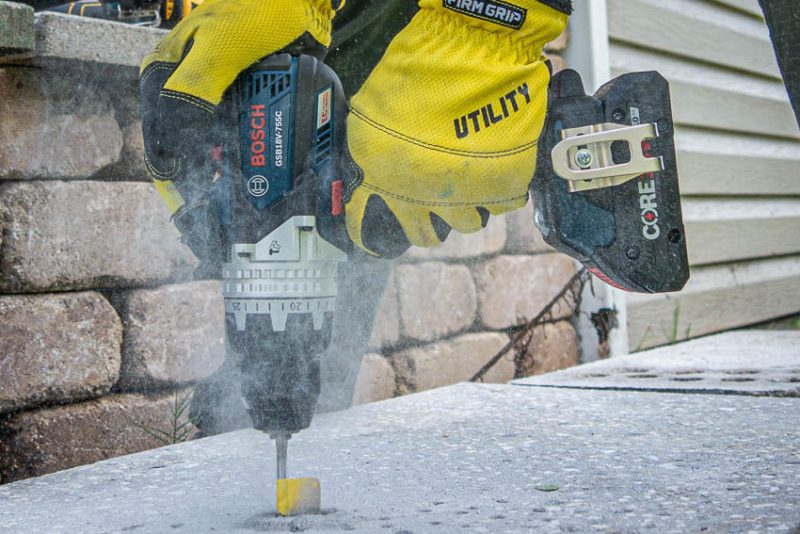
Along with its solid build and excellent ergonomics, the Bosch GSB18V-755C 18V hammer drill features kickback control and comes Connected ready. If you want to enable the smart features by pairing the hammer drill with Bosch’s app, simply pick up the Connected Module for about $19 at your favorite retailer and install it in the handle.
Price: $299 kit with two 4.0Ah Core18V batteries
Best Craftsman Cordless Drill

Even though it’s been around for a while, Craftsman’s CMCD721 is still their top-performing hammer drill. Its brushless motor delivers 2100 RPM and 400 unit watts out of power (read more about UWO vs torque here) to go with a comfortable, lightweight design. Plus, they’re assembled in the USA using global materials by folks in South Carolina. Don’t need the hammer drill mode? Grab the CMCD720 for the same performance in a drill driver instead.
Price: $179 kit with two 2.0Ah batteries
Best Hilti Cordless Drill
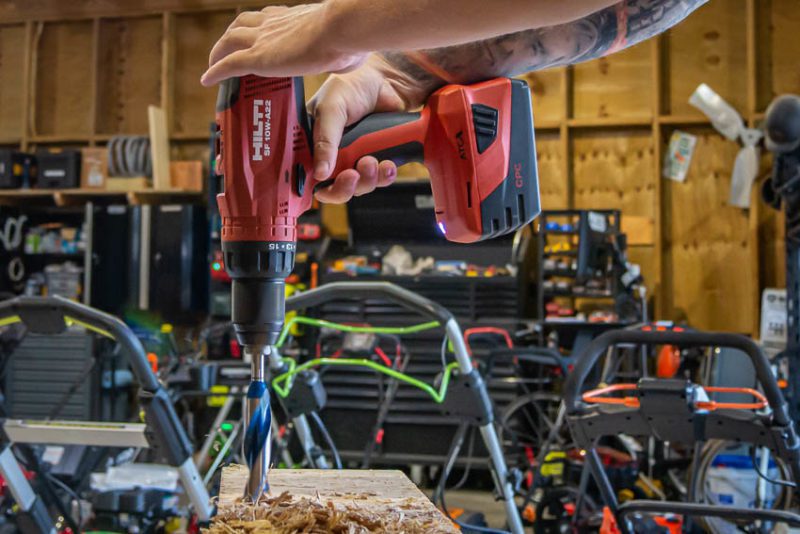
The Hilti SF 10W-A22 is the only brushed drill to make the list. Don’t let that fool you—it’s a drill that can challenge the top position. The lowest of the 4 speeds gives you what we think of as a “mixing” mode with 310 RPM. On the highest gear, it tops out at 2100 RPM. With 1062 in-lbs of torque available and kickback protection, one of the few downsides is that it lacks a hammer drill option.
Price: Starting at $229 (bare tool)
Best Kobalt Cordless Drill
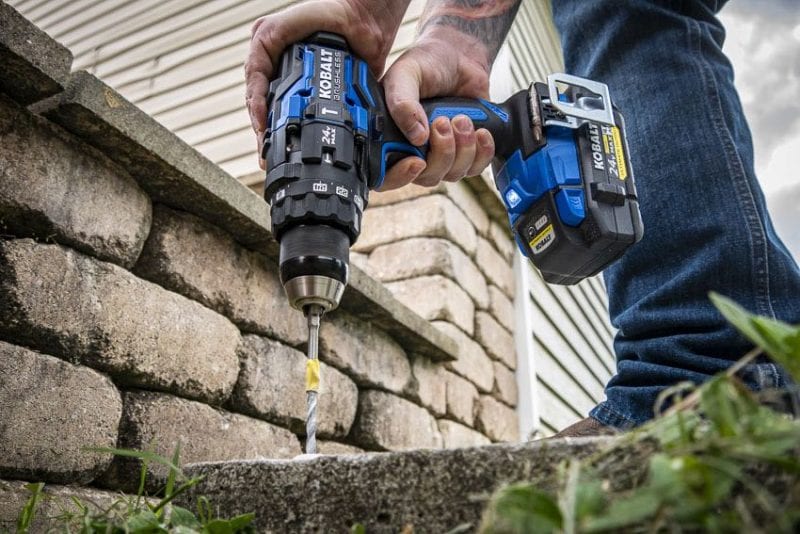
Kobalt made the move to an advanced hammer drill with the launch of their XTR lineup. Highlighted by high performance at a great value, the KXHD 1424A-03 is more compact than Kobalt’s previous model. It also boasts an impressive 1200 in-lbs of torque, 2000 RPM on the top end, and includes kickback control.
Price: $199 kit with 4.0Ah Ultimate Output battery
Best Makita Cordless Drill
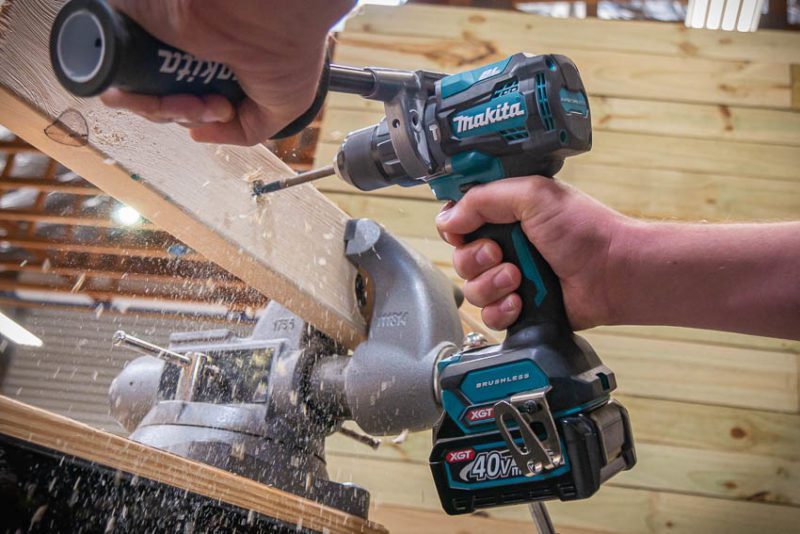
Makita brings their 40V max XGT hammer drill to the competition. The GPH01 is compact at just 7.1 inches long. Still, it packs 1250 in-lbs of torque and pairs that with a top speed of 2600 RPM. Plus, it has kickback control to add a measure of safety as well as an electronic clutch for controlling torque. The 40V max battery is only slightly larger than a 5.0Ah 18V LXT pack. That makes the transition to XGT’s higher performance levels easier. If you’re interested in the 18V XPH14 hammer drill, click here for that review.
Price: $399 kit with two 2.5Ah battery
Best Metabo HPT Cordless Drill

Metabo HPT’s 36V MultiVolt hammer drill has the advantage of using a 36V battery that also works with their 18V tools. Plus, you can add an AC adapter if you’d like to have corded power as an option. Add in solid ergonomics, the safety of kickback control, and a lifetime warranty, and you get a hammer drill to watch closely through our performance tests.
Price: $349 kit with two 4.0Ah batteries
Best Milwaukee Cordless Drill

Milwaukee’s 2804 is the third generation hammer drill for the M18 Fuel line. It’s quite noticeably the most compact model in our test at just 6.9 inches. Hiding inside that small frame is a brushless motor producing up to 1200 in-lbs of torque and 2000 RPM. There’s also a ONE-KEY option if you’d like to explore Milwaukee customizable controls, tool-tracking, and inventory management. Look for the 2806 model if that sounds good to you.
Best Ridgid Cordless Drill

Ridgid took a step back from the size of their Octane line with their updated 18V brushless hammer drill. Much more compact and lighter, it pairs with Max Output batteries to produce 2100 RPM on the top end and up to 800 in-lbs of torque.
Best Ryobi Cordless Drill

Ryobi made a huge leap forward with the introduction of their 18V One+ HP Brushless line. It started with legitimately compact tools and then hit the high-performance end with stronger, yet smaller tools. Our top choice in the Ryobi realm is the 18V One+ HP Brushless hammer drill (PBLHM101). With 750 in-lbs of torque and 2100 RPM on the top end, it actually beat several premium models on the Test Track.
Editor’s Note: Think you know everything? Our How to Use a Drill article might still manage to show you a thing or two.
Cordless Drill Buying Guide | What We Look For
Performance
Performance is our number one priority when we test drills. After all, if the tool can’t do the job you need it to, it’s useless to you!
We test in concrete, wood, and metal. We look to see how a drill’s performance changes as it moves from light-duty to heavy-duty tasks. While we do tests to find each drill’s practical limits, not every drill is capable of doing every job. You won’t find us testing 12V drills with a 2 9/16-inch self-feed bit.
Then there’s the PTR Drill Test Track. Made up of a series of real-world sections, it tells us a lot about a drill’s performance. It starts with 20 drywall screws, showing us the drill’s control. Then it shifts to 10 holes each. We use a 1/2-inch twist bit, 3/4-inch spade bit, and 3/4-inch auger bit to cover medium-load jobs. Finally, it wraps up with 1-inch and 2 1/8-inch hole saws to put them under a heavier load. The clock doesn’t stop until the final hole saw breaks through, so bit changes and human error have an effect.
Size and Weight
Most of the time, the more compact and lighter the drill, the better. It helps you work in tighter spaces with less fatigue. For the most part, we want to use the smallest, lightest drill we can that still gets the job done.
Ergonomics
There’s something to be said for a drill that just feels right in your hands. Balancing the weight certainly comes into play. However, most of us find that certain brands’ handles fit better in our hands than others. Try picking up a few different ones next time you’re in a home improvement store. See what works best for you.
Features to Look For
There are a lot of features to consider. Not all of them are necessary, but they can make getting the job complete easier, less fatiguing, or safer. Here’s what we look for:
- Multiple speeds: 2 speeds is a must, more is generally better
- Kickback control: stops the motor if the bit binds up
- Side handle: absolutely necessary on drills with higher torque
- Smart controls: helps with inventory management and tracking, some offer customizable controls
- Brushless motor: longer runtime, better performance, and longer motor life
- Interchangeable chucks: switching to a specialized chuck can get you out of a sticky situation
- All-metal chuck: better durablity
- LED light: nearly every drill has one, but our favorites put the light(s) around the chuck
- Belt hook: usually reversible, they’re super-helpful when you have materials to carry or your climbing a ladder
Price and Value
Most of us have some sort of budget we’re working with when buying a cordless drill. Staying under budget while getting the most bang for your buck is key.
That’s not all that goes into it, though. Consider what other tools are compatible with the same batteries. A deep line ensures you can easily add more tools without having to buy a different battery and charger.
Warranty plays a big part as well. Some are as short as a year (or even shorter, but we typically don’t recommend those). Others stretch out to 5 years—and still others offer a lifetime guarantee. Also, keep in mind how you’re going to get service after the sale if you need to use the warranty. Having a convenient service center close by can save you the cost of mailing in a tool.
Finally, consider where you’re going to get new batteries or expand your tool collection. It’s convenient to shop online, but being able to walk into the store and grab what you need when you need it is a big deal. If you’re a Pro, keep in mind the dealer relationship. Whether you’re in a situation where the dealer comes to you or you go to the dealer, having someone that’s willing to help you out when you get in a jam can save you time and money.
Why Cordless Drills?
Few power tools are as basic for both professionals and homeowners as cordless drills. At its core, these are hole-making tools. They help us hang pictures, run wiring and plumbing, create pilot holes, and a host of other projects that require a hole in wood, metal, or drywall.
But the best cordless drill does more than that now. Drill clutch settings give us control over screw driving. Hammer modes let us drill smaller holes in concrete and masonry. In short, cordless drills let us drill and drive in almost any material without the need for a cord.
Why You Can Trust Pro Tool Reviews
Ever check out a “review” site and you can’t tell if they actually tested the tools or if they’re just “recommending” the Amazon top sellers? That’s not us. We won’t recommend anything unless we’d actually use it ourselves, and we don’t really care who the primary retailer is. It’s all about giving you a legitimate recommendation and our honest opinion of each product.
We’ve been in business since 2008 covering tools, writing reviews, and reporting on industry news in the construction and lawn care industries. Our Pro reviewers work in the trades and have the skills and experience to know whether tools can perform well in the field.
Each year, we bring in and review more than 250 individual products. Our team will put our hands on hundreds of additional tools at media events and trade shows throughout the year.
Pro Tool Reviews consults with innovators in the technology and design of tools to gain a broader grasp of where these products fit and how they work.
We work with more than two dozen professional contractors around the United States who review products for us on real job sites. We consult with them extensively on testing methods, categories, and practical applications.
Our site will provide more than 500 pieces of new content this year absolutely free for our readers. That includes objective evaluations of individual tools and products.
The end result is information you can trust because of the editorial, scientific, and real-world professional experience we collectively utilize each and every time we pick up and test a tool.

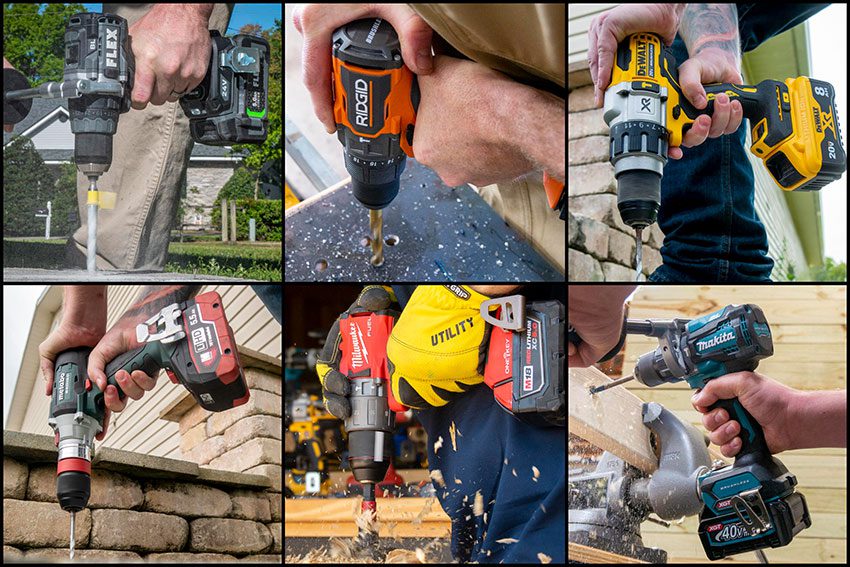
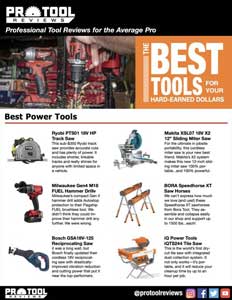


I’d liked to have have seen the newer Bosch 18v gsr/gsb 975 or the brand new gsr 18v 1330 drill once it’s available. It’s supposed to be their best yet with 1,330 in. lbs. of torque. Their latest models numbers represent their max torque capacity.
I have no idea what kind of test you used, or if this a truly impartial independent review site, but I am glad I came here to search for a specific needs cordless I need for a new job. The Bosch GSR12V-300FC fits the bill perfectly, and I did not even know it exist. I just ordered it from my local Lowes and am picking it up tomorrow and will be deploying it on Monday. Thanks for the help!
It pains me to watch some of the tests from other youtubers that push the tools beyond their limits because not all of them have anti kickback feature, which I think it’s important to have as you move towards heavy duty applications. I have seen countless workers getting their wrists twisted from Dewalt.
This is a tough thing for us internally as well. We found that in the past we were able to publish all that data, however, updating all those articles and chart graphics every time a new tool came out became untenable. The result was that our articles sat unchanged for a year or more and didn’t include the newest tools. Now, we’re able to more quickly update our rankings and articles based on high-quality testing. We do recognize that we had to give up producing new graphics for every update. To help compensate, our video editor started including charts in… Read more »
Where can I see the data used to make the determinations in the article? I’m interested in the numbers used to come the conclusions.